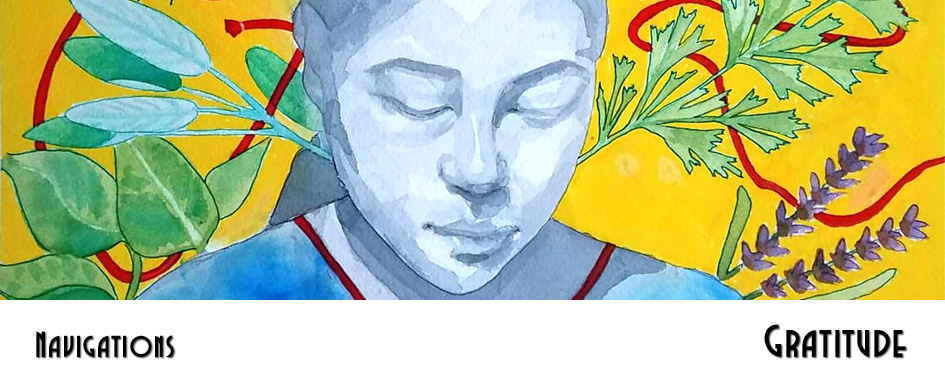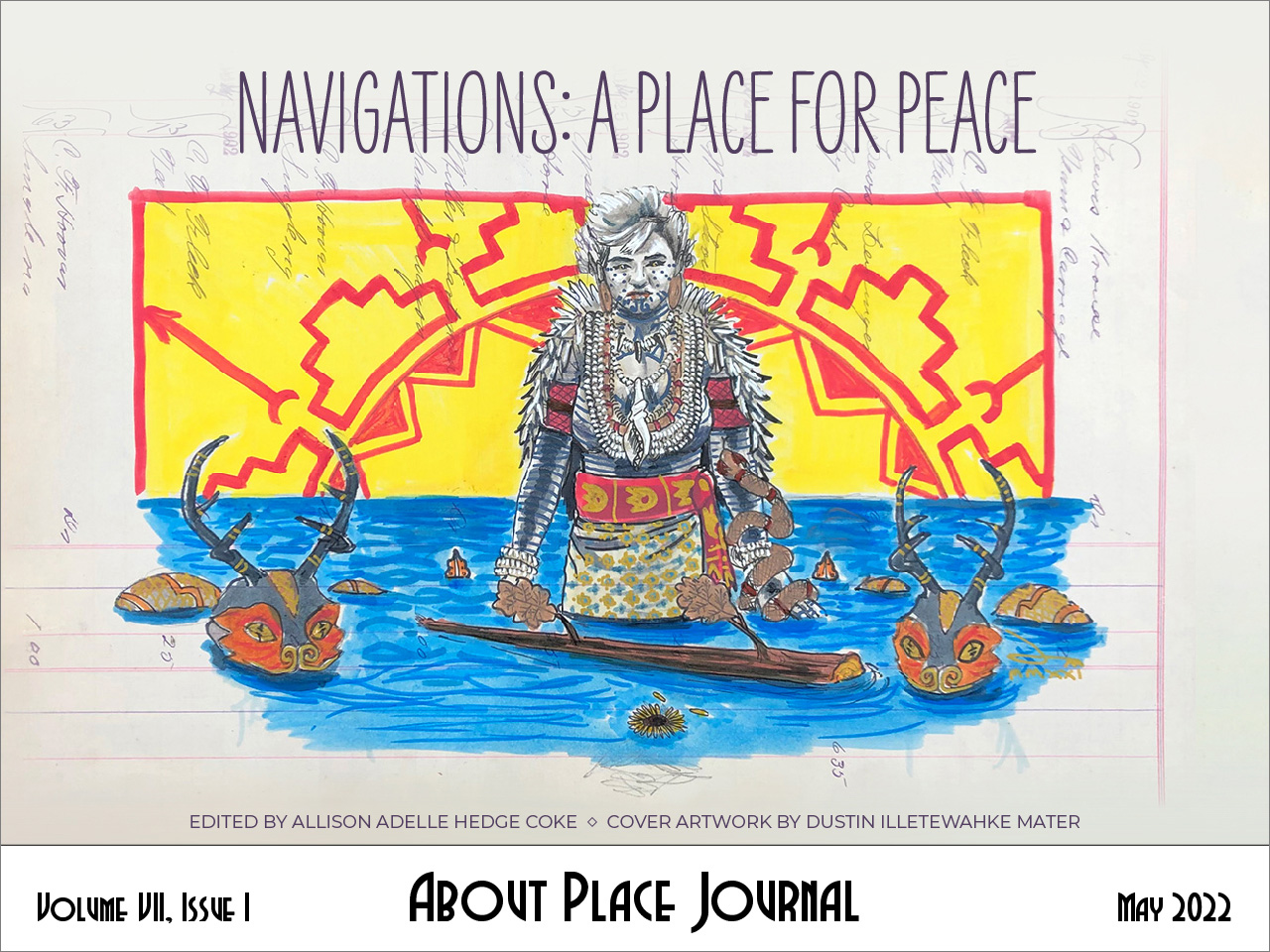There are still times when I feel like I am floating, not connected to any kind of where, not grounded or rooted, or having a sense of belonging. I grew up in the rural Appalachian countryside of east/central Pennsylvania. In conversation, I may identify my childhood home more by what it is near, rather than where it is. I might say, “it is about an hour north of Harrisburg,” or “it’s just east of State College.” Our postal address was Middleburg, although the actual borough of Middleburg seemed a thousand miles away when I was a child. In relation to neighboring towns, we lived in the nameless in between, in the “middle of nowhere,” in a haze of hills. I spent my days wandering fields and looking up into the ceilings of trees. I marked time through the color phases of maple leaves until they fell and blew away.
Our ranch house was surrounded by corn fields on all sides except for the dirt road at the end of our driveway and a few other houses dotted here and there. During the growing season, our house was boxed in by corn. Hidden from the rest of the world, I used to run through the green tunnels while shielding my face from the waving arms of the corn stalks. Sometimes, if I ran far enough, I would reach the end of a field that opened up into a graveyard.
I grew up in the presence of corn and the dead.
Near my house, there was a small cemetery that any traveler heading east would need to pass before dropping down a steep hill that landed in the small town of Freeburg, another Pennsylvania “burg” with a curious name. Nothing about my life seemed free to me back then. I saw the cemetery every day, either on foot, on a bike, or in a car. It was the north star in the landscape of my childhood, and more often than not, when alone, I would step into the hallowed ground and read the names of the dead out loud to the wind. I always believed someone was listening. I never doubted it.
Rather than being afraid of ghosts, I called out to them.
My love for cemeteries followed me throughout my life, and one time led me to an old family graveyard during an autumn geocache outing near Raleigh, North Carolina. Under a canopy of golden poplar leaves, I studied the sunken, gentle mounds marked by odd-shaped stones with weather-worn initials etched by hand. There was nothing else around except woods. No house. No road. Only the rough trail that led me there and the geocache box filled with rusted trinkets.
I was reminded that before the funeral industry, people took care of their own. And there are those from cultural traditions, such as Jewish, Muslim, and Indigenous communities, who always have. Someone dug these graves by hand, searched the land for the perfect flat-faced stones, and etched those initials with fingers wet from wiping tears away. Someone laid those bodies down into the graves with their own arms, shaking from weight and grief. Who were they and what did they know about death that I still needed to learn?
I spent most of my life walking through conventional cemeteries and yet never imagined myself being buried in one. I walked cemeteries seeking peace. I felt surrounded by slumbering people and their quiet lingering spirits. I sometimes moved my hands across the etched gray headstones, death symbols the deceased likely never laid their hands on. For those who are grieving, it is something to touch, something to lean on, but I never envisioned a large, square, concrete stone with my name on it. I assumed I would be cremated and that my ashes would be tossed into the sea. I didn’t see myself being laid to rest in a fixed location. I wanted to be free. But this idea of being scattered at sea has, like my dream of it, dispersed into the wind. The more I imagine my body being pushed into a crematorium and set on fire, the less I want it.
Flame cremation feels violent. I understand the attraction. Fire is the ultimate purifier. All of your diseases, your troubles and terrors, your sins and misdeeds, all go up in flames so your soul can carry on, unencumbered, to its next port of call. Your body becomes smaller with the ability to simply blow away. It is reduced to pulverized bone that can pepper and nourish the planet, except not quite, not without significant nutrient help. Ashes, body sand, human cremated remains, or what mortician Caitlin Doughty calls “people dust,” is primarily calcium phosphate and sodium, a highly alkaline chemical composition that is not bioavailable to the surrounding soil when scattered or buried, or conducive to feeding flowers and trees. In addition, the pollution and carbon footprint of flame cremation is too heavy for the shoulders of this planet to bear.
These days, when I walk through a cemetery, the kind similar to the one that haunted the landscape of my childhood, I think of formaldehyde, concrete, endless mowing, plastic flowers, glossy caskets, and headstones lined up like gray envelopes in a filing cabinet. I love the craggy trees and meandering roads, but a walk through a conventional cemetery today leaves me cold and conflicted.
In the fall of 2019, I began doing volunteer work for Heritage Acres Memorial Sanctuary in Pierce Township, Ohio, near Cincinnati. Heritage Acres is a 40-acre natural burial ground and nature preserve characterized by rolling meadowlands, serene forests, and a bowl-shaped memorial garden filled with soft-stem bullrush and sweetgrass. My first visit to Heritage Acres was a blue-sky Saturday in October for a volunteer community work-day roughly six months before this “green” burial ground officially opened in April of 2020. I spent more time gazing at the soft yellow hair of the fall goldenrod and the expanse of the landscape than clearing the patch of thicket where I was working. I was mesmerized.
Slowly and softly through this volunteer work, death emerged in my mind as a wild biological event, an opportunity to claim one’s birthright within the disorderly and fiercely fundamental essence of being a living and breathing organism. It is a wild form of love to envision your cells as soil, to fearlessly surrender your body to microbial absorption, to participate in this ancient sacred service to the earth. It became clear to me.
I want a soft goodbye.
I do not want to be lowered into a hard cement vault that separates me from my biological ability to support the earth after my spirit has left my body. I want to be wrapped in a soft, clean cotton blanket or shroud and lowered onto a bed of biomass made of rose petals, wildflowers, and evergreen boughs that will accelerate my un-embalmed body’s melt back into the biome. I want to be grounded and rooted. I want to become dirt. I want to be loam. I want to be soft.
I also want to be useful. Down within the dark earthen network of roots, I want my molecules, soft tissues, skin and bones, my mouth, hands, and all that has enabled me to carry and express myself as human, to be broken down by cadaver insects, microbes, and mushrooms spores to support the enduring work of soil. I want my body and biological signature to be a player in this creative and regenerative process. Let the blowflies and flesh flies have their way with me. It is one last offering after a lifetime of consumption.
A green burial is soft on the atmosphere, soft on the soil, and soft on the heart. It is a burial ritual that is an act of preservation for the earth and an honoring of the body’s innate and instinctive ability to decay. Natural burial cemeteries are nature preserves for the dead and grieving, lined with paths that lead to a deeper acceptance of our brief and delicate human life cycle. They remind me that soon, it will be time to go, and I should not waste time. When it is time for my spirit to leave my body, I can say goodbye softly, wildly, and with love.
On another warm blue-sky October Saturday in 2020, close to my one year anniversary doing volunteer work with Heritage Acres, I poured a box of rose petals that I plucked from my own overgrown rose bushes into the mouth of an open grave for a burial. I wandered the woods and gathered paw-paw leaves, evergreen boughs, and ferns to add to the grave while Nine Mile Creek trickled in a ravine nearby. Later that day, friends and family members surrounded that grave and lovingly lowered a loved one into the bed of colorful biomass amidst a backdrop of rust and flaxen autumn leaves.
After a lifetime of kinetic activity, of movement from one place to another, the where in my end-of-life planning matters. I want to feel an intimate and familial bond with the soil that will ultimately consume me with its elemental and transformative grace. Where and how I choose to be buried is the last note of the only song that truly belongs to me, my final opportunity to say I love you to whomever, or whatever, is listening.
I love you.


